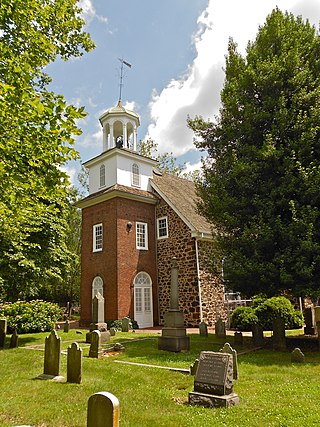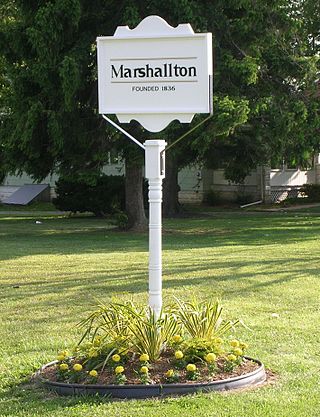
New Castle is a city in New Castle County, Delaware, United States. The city is located six miles (10 km) south of Wilmington and is situated on the Delaware River. As of 2020, the city's population was 5,551. New Castle constitutes part of the Delaware Valley or Philadelphia metropolitan area.

Holy Trinity Church, also known as Old Swedes, is a historic church at East 7th and Church Street in Wilmington, Delaware. It was consecrated on Trinity Sunday, June 4, 1699, by a predominantly Swedish congregation formerly of the colony of New Sweden. The church, designated a National Historic Landmark in 1961, is among the few surviving public buildings that reflect the Swedish colonial effort. The church is considered part of First State National Historical Park. The church, which is often visited by tourists, remains open for tours and religious activities.

Marshallton is an unincorporated community in Mill Creek Hundred, New Castle County, Delaware, United States. The community was founded in 1836 and is named for John Marshall, mill owner.

The Grand Opera House, also known as The Grand or Masonic Hall and Grand Theater, is a 1,208-seat theater for the performing arts in Wilmington, Delaware, United States. The four-story building was built in 1871 by the Delaware Grand Lodge of Masons to serve as a Masonic Temple and auditorium. The construction cost was $100,000. It was designed in Second Empire style by Baltimore architect Thomas Dixon and incorporates symbolism from Freemasonry into the cast-iron facade. Its central pediment contains an Eye of Providence.

The F. W. Woolworth Company Building is a historic department store building located in downtown Wilmington, Delaware.
This is a list of properties listed on the National Register of Historic Places in Wilmington, Delaware:

Old Town Hall is a historic town hall located at Wilmington, New Castle County, Delaware. It was built in 1798, and is a large two-story brick building in a late-Georgian / early-Federal style. The roof is gently sloping and is topped by a large octagonal cupola and once had a wooden balustrade. The building housed the Wilmington city government until 1916 and served as a focal point of many public events in Delaware's history. The property is owned and managed by the Delaware Historical Society

Crosby and Hill Building is a historic commercial building located at Wilmington, New Castle County, Delaware. It was built about 1859, with the present facade added in 1920.

Max Keil Building is a historic commercial building located at Wilmington, New Castle County, Delaware. It was built about 1850, and modified in the Art Moderne / Art Deco style in 1938. It is a three-story, single-bay commercial building with a rectangular plan built of wall bearing brick construction. The front facade features a large curved glass display window on the first floor and an austere, peach-colored terra-cotta wall with a large rectangular window of structural glass block at the second and third floors.

Max Keil Building is a historic commercial building located at Wilmington, New Castle County, Delaware. It was built about 1875, and modified in the Art Moderne/Art Deco style in 1938. It is a three-story, single-bay commercial building with a rectangular plan built of wall bearing brick construction. The front facade features large display windows on the first floor and an austere, peach-colored terra-cotta wall with a large rectangular display window at the second and third floors. In 2010, it was occupied by an outlet of Rainbow Shops.

Charles Gray Printing Shop was a historic commercial building located at Wilmington, New Castle County, Delaware. It was built in 1874, and was a three-story, commercial/office building with a rectangular plan built of wall bearing brick construction. It featured a half-octagonal display window and is in the Italianate style. The building was demolished and replaced with an office of the University of Delaware.

Reynold's Candy Company Building is a historic commercial building located at Wilmington, New Castle County, Delaware. It was built in 1929 as a restaurant and candy factory. It is a three-story, three bay commercial building with a rectangular plan built of wall bearing brick construction. It features a curved cast metal canopy over the front doors, an ornate white terra cotta facade, terra cotta panels with stylized vine pattern relief, and is in the Beaux Arts style.

Henry Townsend Building is a historic commercial/residential building located at Wilmington, New Castle County, Delaware. It was built in 1913–1914, and is a four-story, five bay commercial apartment building with a rectangular plan built of wall bearing brick construction. It features a limestone facade with ornate denticulated cornice supported by four large brackets in the Beaux Arts style. Between 1922 and 1964, the first floor was used as a W. T. Grant Department Store.

Braunstein's Building is a historic commercial building located at Wilmington, New Castle County, Delaware. It consists of two buildings built about 1900, and combined in 1924 as a single unit. The building at 704 is a four-story, two bay brick commercial building and the buildings at 706 is a four-story, three bay brick commercial building. It features a unifying first floor display window made of pressed metal, with accents of raised bands, panels with basket weave design, and stained glass in the Beaux Arts style. The storefront was added in 1924.

Charles B. Lore Elementary School is a historic elementary school building located at Wilmington, New Castle County, Delaware. It was built in 1932, and is a 2+1⁄2-story, E-shaped red brick building in the Collegiate Gothic style. It features a four-story central tower, steep pitched, slate gable roof, stone surrounds on windows and doors, and battlements above entryways. The school was named for Charles B. Lore (1831-1911). It was closed in 1981 because of declining enrollment. It was later converted to an assisted living facility.

Foord & Massey Furniture Company Building is a historic warehouse and showroom located at Wilmington, New Castle County, Delaware. It was built between 1917 and 1919, and is a five-story, five bay by four bay, brick commercial building. It has Collegiate Gothic Revival elements, one of the few commercial buildings in the immediate area designed in this style.

Delaware Avenue Historic District is a national historic district located at Wilmington, New Castle County, Delaware. It encompasses 180 contributing buildings and 1 contributing structure developed in the late-19th and early-20th centuries. The district is primarily residential and includes a variety of Victorian-era mansions and large dwellings in a variety of popular architectural styles including Italianate, Queen Anne, Colonial Revival, Classical Revival, and American Four Square The houses are detached or semi-detached and are primarily three stories in height with extensive wings to the rear. The district also includes 20th century apartment complexes. Also located in the district is the St. Stephen's Lutheran Church and the Sailors and Soldiers Monument. The separately listed Howard Pyle Studios are also located in the district.

Downtown Wilmington Commercial Historic District is a national historic district in Wilmington, New Castle County, Delaware. It encompasses 44 buildings in the city's downtown, most on North Market Street between 6th and 9th avenues. The district was the commercial center of the city between roughly 1870 and 1968, and contains an architecturally distinguished collection of late 19th- and early 20th-century architecture. The Grand Opera House, built in 1871, is the oldest surviving building in the district.

The J.G. McDonald Chocolate Company Building in Salt Lake City, Utah, United States, is a 4-story commercial structure designed by John A. Headlund and completed in 1901. The original 3-story brick and stone building was expanded to four stories soon after construction, and it continued to expand as the company grew. The building was added to the National Register of Historic Places in 1978, and it is now included in the Warehouse District.

The Delmarva Power & Light Building, also known as the DCAD Building, is a historic office building in downtown Wilmington, Delaware. The former headquarters of Delmarva Power & Light (DP&L) is listed on the National Register of Historic Places.























